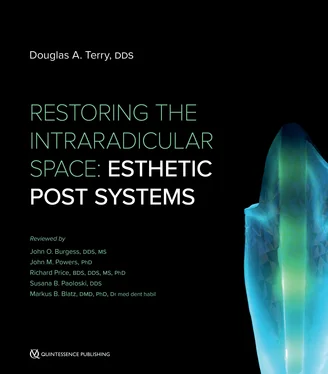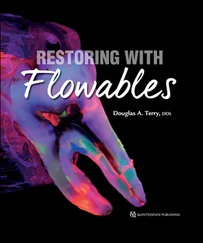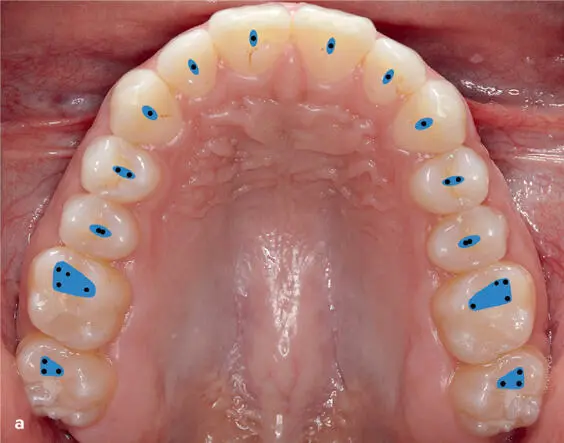
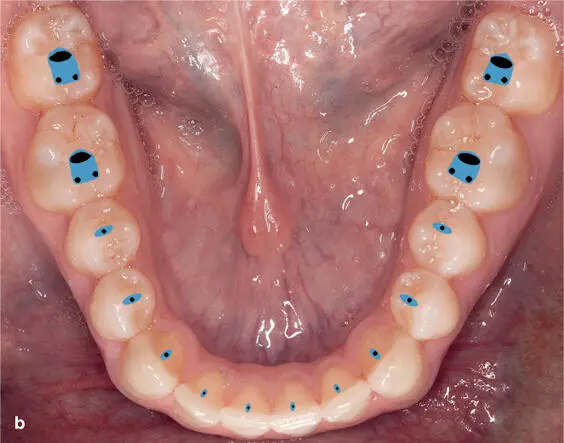
Fig 1-7 (a and b) Conservative endodontic access openings.
Improvements in composite materials, adhesive technology, and endodontic procedures and technology have resulted in a more conservative design concept. 9This minimally invasive concept preserves intact tooth structure, reducing the potential for failure209 while providing adequate retention and resistance form for the final restoration. 40
One method of the direct fiber-reinforced resin post system (see section entitled “Direct Fiber-Reinforced Post and Core System”) allows preservation of the canal structure and can be utilized in the treatment of irregular canal configurations. This procedure does not require a converging path of insertion and can be used with minimal preparation because it utilizes the undercuts and surface irregularities to increase the surface area for bonding (see Fig 1-9). This conservation of dentin reduces the possibility of tooth fracture during function or in the event of traumatic injury.287
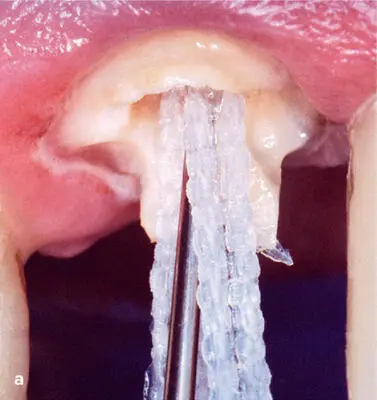
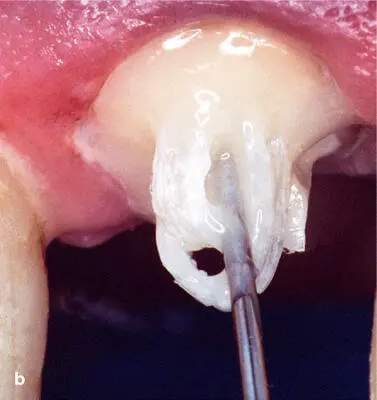
Fig 1-9 (a and b) The intraoral fabrication of a direct fiber-reinforced post using a plasma-coated fiber ribbon. After the adhesive protocol and injection of a dual-cured resin cement, the fiber is immediately inserted into the posthole with a modified Luk’s gutta-percha condenser, and the fiber is folded over so that the ends are pointing back into the post channel and between the emerging ends of the fiber. This method allows preservation of the canal structure and can be utilized in the treatment of irregular canal configurations.
Internal adaptation
Conventional luting cements such as zinc phosphate only fill the void between the restorative interfaces without attaching to either surface. 55Dual-cured resin luting agents mechanically and chemically interact with the resin of fiber-reinforced composite resin posts and the dentin, which bonds and seals the adhesive interface. Previous methods of cementation have been investigated that include placement of the cement onto the post and/or placing the cement with paper points, an endodontic explorer, and lentulo spiral.175 ,340 ,341 The lentulo spiral was considered the superior method of placement, providing a uniform thickness of cement with no voids.341 The author prefers placement of the adhesive resin cement onto the post and injection of the material with a needle tube placed at the base of the prepared post space, slowly removing the syringe tip to prevent the formation of air voids196 ( Fig 1-8). The use of composite resin cements between the adhesive system and the reinforcement material ensures a more intimate contact with the dentin bonding agent because of lower viscosity that results in enhanced adaptation.342 One study claims that low–elastic modulus composite acts as an elastic buffer that compensates for polymerization shrinkage stress by flow, minimizing gap formation and reducing microleakage343; however, there is no evidence that flowable-lined composite restorations have improved margins or reduced leakage. If the elastic modulus is low, the composite will flex as the tooth bends, thus minimizing fracture. Also, lower-viscosity resin cements enhance post and dentin wetting, improving the interfacial internal adaptation and reducing void formations that contribute to reduced post retention and increased microleakage.344 Therefore, the use of a resin luting cement to line and strengthen the canal walls actually reinforces the root and supports the tooth-restorative complex166 ,345 ( Fig 1-9).
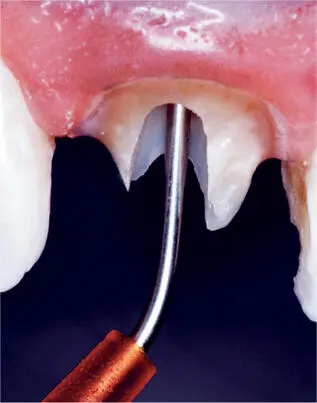
Fig 1-8 A dual-cured composite or resin cement was injected into the post channel with a needle-tube syringe. It is important to place the tip to the base of the channel and inject slowly while removing the tip slowly.
Optimal esthetics
When esthetics is of primary concern, the selection of appropriate restorative materials becomes an important consideration. The purpose of selecting tooth-colored posts for enhancing esthetics in ETT is to aid in the creation of a natural-looking restoration. An esthetic post prevents the dark showthrough that so often is observed with a metal post.346 The light-transmission properties of traditional prefabricated or cast-metal posts differ from natural teeth where light is reflected, absorbed, or transmitted through the tooth. The incidental light is completely blocked by the metal post, which causes the characteristic shadow at the submarginal zone.347 When using an all-ceramic restoration, the color and opacity of the metal post may lead to discoloration and shadowing at the gingiva and cervical region of the tooth.173 ,348
The secondary optical properties (eg, translucency, opacity, opalescence, iridescence, and fluorescence) of the composite allow light to pass through the natural tooth and the restorative material to reflect, refract, absorb, and transmit according to the optical densities of the hydroxyapatite crystals, enamel rods, and the dentinal tubules.349 Composite fiber-reinforced post systems made of quartz and glass provide these secondary optical properties for reproducing the various optical characteristics that are observed through the enamel and the dentin. 42 ,173 Therefore, in creating optimal esthetic harmony with the surrounding dentition, the underlying restorative material directly influences the final restoration ( Fig 1-10; for more information, see chapter 3).
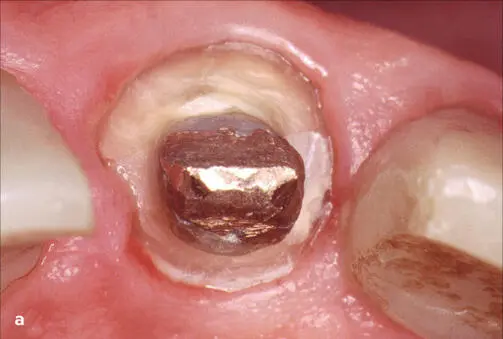
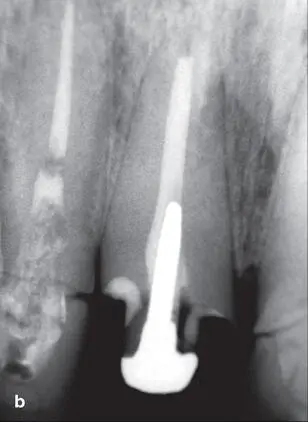
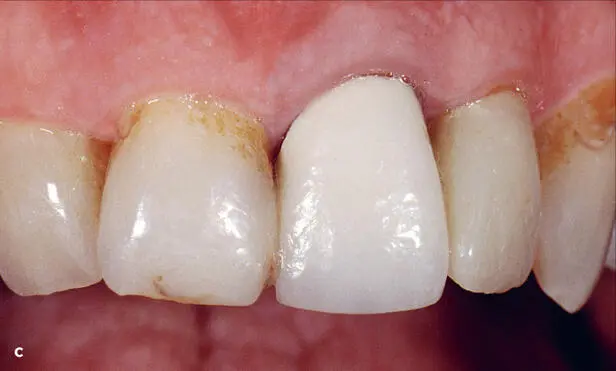
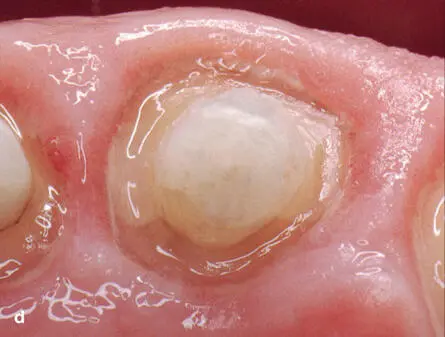
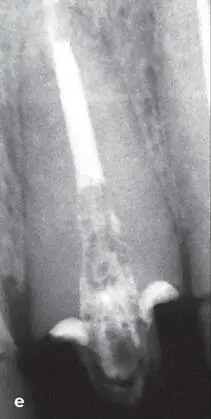
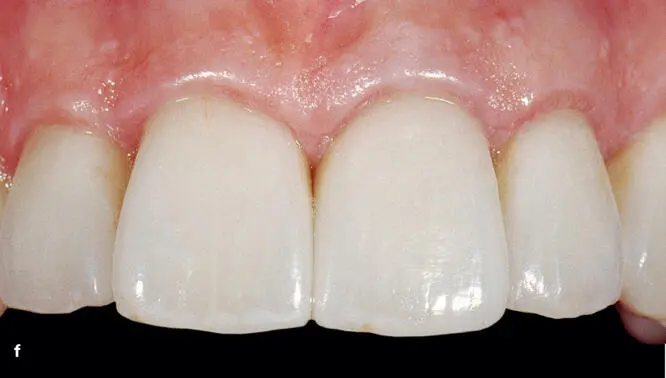
Fig 1-10 (a to f) A comparison of a metal-ceramic crown with metal post and the same tooth with a direct fiber-reinforced post with all-ceramic crown. The incidental light is completely blocked by the metal substructure of the metal-ceramic crown and the metal post, causing the characteristic shadow at the submarginal zone. Notice the improved light transmission of the restored tooth with the direct fiber-reinforced post system and all-ceramic crown as well as the improved color of the soft tissue.
Читать дальше
